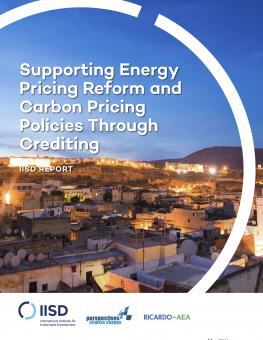
Supporting Energy Pricing Reform and Carbon Pricing Policies Through Crediting
This study examines the role that policy crediting might play in increasing the mitigation impact of energy pricing reform and carbon pricing policies.
Policy crediting—i.e., the crediting of the emission reductions resulting from the implementation of a policy action or components of it—is a new concept, and so far there are no real case examples.
Some work has been done on regulatory policies (such as energy-efficiency standards, including under the Clean Development Mechanism [CDM] and with an aim to reforming the CDM beyond a project-level scope) both from the methodological side and through blueprinting of operational models. Similar approaches were developed for policies such as feed-in tariffs for renewable energy.
The potential crediting of implicit or explicit carbon pricing policies is uncharted territory. Anecdotally, the CDM played a major role in building capacity, awareness and interest in many countries to implement domestic carbon pricing schemes to provide their economies with a price signal.
Crediting of carbon pricing policies might be a way to support countries further and on a higher scale in these efforts. It might also be possible to achieve much larger emission reductions and international carbon flows in crediting such policies than what CDM and Joint implementation (JI) have achieved.
This study examines the role that policy crediting might play in increasing the mitigation impact of energy pricing reform and carbon pricing policies (pricing reform). This can either be through:
- A policy being implemented that would not have been without crediting; or
- An existing policy or one that has been decided upon is made more stringent (i.e., that its mitigation impact is increased).
The study developed four detailed case studies analyzing pricing reform undertaken in developing countries:
- Morocco – energy subsidy reform
- Indonesia – energy subsidy reform
- Mexico – carbon tax
- Beijing (China) – pilot emission trading scheme (ETS)
Based on the case studies, three options for policy crediting are recommended for further consideration and in-depth assessment on a case-by-case basis:
- Support emission reductions at the policy margin.
- Support emission reductions within the policy instrument.
- Overcome barriers to effective policy implementation and operation.
The above-mentioned options are generic in nature, reflecting that crediting related to pricing reform has not been undertaken in practice, in the developing world or elsewhere. All crediting approaches assessed would therefore benefit from further work, to develop monitoring, reporting and verification (MRV) for each pricing reform policy, to evaluate potential options with countries, and to better understand policy design and political economy challenges.
You might also be interested in
Five Key Priorities to End Fossil Fuel Subsidies in Canada
As the G7 president in 2025, Canada has a pivotal opportunity to lead by fully phasing out fossil fuel supports and investing in a cleaner, more equitable future. Here are five recommendations for effective subsidy reform.
Increased Support Needed to Achieve India's Clean Energy Goals
India is on track to achieve many of its 2030 clean energy goals but needs to step up government support measures to accelerate the deployment of offshore wind, electric vehicles, and green hydrogen, according to a new report.
Ending Export Credits for Oil and Gas: How OECD countries can end 2024 with a climate win
For a year now, Organisation of Petroleum Exporting Countries (OECD) governments have been negotiating an agreement that could put an end to oil and gas export finance. Following the acrimony in Baku, this would be a very real way for the OECD to show policy coherence, respond to calls from the poorest countries to stop subsidizing fossil fuels, and shift public finance to solutions.
Fossil Fuel Production, Renewable Energy, and Subsidy Reform in Nationally Determined Contributions 3.0
This policy brief provides an analysis of the critical benchmarks and recommendations necessary for aligning nationally determined contributions (NDCs) with the 1.5 °C target.